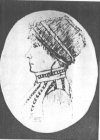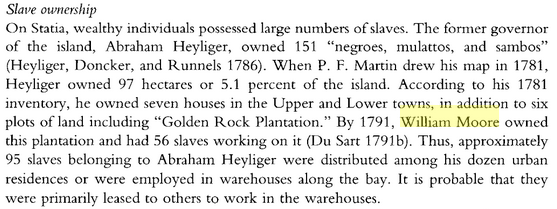Ancestry of Elizabeth Patricia Cameron (*1855)
|
Page AS III.8 to overview
|
Donald Charles Cameron
(3rd of Donie)
* 1745 Dounie,
Kilmonivaig
+ |
Isabella MacMartin
* 1755 Letterfinlay, Inverness
+ |
|
|
|
|
Sieur Joseph Serane
*
+ after 03-1803 Guadeloupe?
(French Navy; Notary public) |
Henriette Bruce/Brousse
*
+ Guadeloupe |
x before 02-1795 Guadeloupe |
|
John Cameron
* 1774
+ 30-04-1853 Kintall, Ross-shire, Scotland |
Isabella Kenedy
* 11-1785 Kilmonivaig, Argyll, Scotland
+ |
x
14-11-1804 Kilmonivaig, Argyll |
|
Peter Moore
* 18-10-1792 St Martin (Caribbean)
+ ca 1830, disappeared in Guiana |
Marie Francois Adele Serane
* 25-11-1798 Basseterre, Guadeloupe
+ 1885 London, England |
x 19-06-1815 St Martin (Caribbean) |
|
Donald Charles Cameron
* 14-08-1814 Castle Orgueil, Jersey
+ 25-10-1872 Home Creek, Barcoo, Qld Austr. |
Margaret Ann Moore
* 30-11-1819 St Eustache, West Indies
+ 08-03-1918 Toowoomba, Qld Australia |
x 08-05-1844 Berbice, British Guiana more.... (as481m.html) |
|
Elizabeth Patricia Cameron
* 9-07-1855 Native Creek Stn, Meredith, Vic (Australia)
+ 25-11-1951 Toowoomba, Queensland x William Justin Beauchamp Cameron |
For the history of the Cameron Clan look at the websites
Clan Cameron Online
and Wikipedia
Clan Cameron.
The branch Downie/Dawnie above is a branch of the "Glen Nevis clan".
Data on births, marriages etc of the Cameron branch:
AncestryResearchService,
enter as search name: Cameron, Donald Charles.
See also "History of the Camerons, with genealogies of the principal
families of the name" by Alexander
Mackenzie (1884), p.403.
"Donie or Dawnie family stem from Donald Dubh, 2nd son of Alexander Cameron, 8th of Glen Nevis.
The son of Donald Cameron, Allan, 1st of Donie, lived there ca 1712,
as shown in a Charter of Glen Nevis dated 1712.
His son Ewen was knighted by Charles Stuart in 1745."
He thus called his next son Donald Charles (first Cameron with these names);
many boys thereafter had the same.
|
Relevant Caribbean historic background:
In 1776, the people in the British Territories in North America
revolted against the governance of England,
initially a protest against taxation (the "Boston Tea Party").
For their struggle they needed weapons and the Dutch were all to
willing to provide them. This trade developed from
the island of St Eustache in the Caribbean.
The British tried to prevent this trade by diplomatic means.
Since the Dutch did not budge, war was declared
(4th Anglo-Dutch sea war 1780-1784).
1781: The British invaded St Eustache (see image;
Wikipedia), later that year invasion by the French, who stayed until 1784.
Its economy faltered.
At the peace treaty (1783),
St Eustache was given back to the Dutch.
1781: The dutch lost the colony of Berbice
(and neighbooring colonies) to England (later British Guyana).
1795: During the wars with Napoleon,
Guadeloupe was taken by England from the French.
|
Donald and Isabella
Ewen Cameron (the father of Donald) of the Glen Nevis clan,
had participated in the
"Jacobite uprising"
and after the battle at Culloden in 1746 became fugitive.
He returned to Scotland impoverished, his lands and titles being confiscated.
The Duke of Gordon, who not officially had joined the uprising,
still held position and lands and he leased Cameron a 99 acre farm,
"Leanassie" in Kintail (MCR p.6-8).
Later, son John would succeed in this lease.
Isabella was the daughter of George MacMartin-Cameron.
Children (in Argyll, Scotland): Allan, Anne, Mary, three more,
1774 John,
1780 Ewen, 1781 Donald Charles,
1782 Angus, 1788 Catherine.
Son Donald Charles became the financial success of the family.
He migrated to Berbice in British Guiana where he became plantation owner.
When he (still a bachelor) returned to Scotland he bought
castle "Barcaldine"
(see image),
a castle that his nephew Donald (son of brother John)
thought he might inherit.
But nephew Donald married and got heirs of his own.
William Moore and Adrienne
William decended from nobility in Ireland (info from
The Heyliger family
in the Caribbean: branch "Fac"),
presumably from the Earls of Drogheda, Ireland.
There is a charter decorated with the coat of arms of the bride and
groom: HEYLIGER and MOORE, descendants of the Earls Of Drogheda.
According the mariage registration of son Peter in 1815,
William and Adrienne were landowners on St Eustatius.
He later bacame Councillor on St. Eustatius (Raad van St. Eustatius).
Children (not complete):
1782 Elizabeth (x James McInroy Esq. of Lude Perthshire, 1769-1825,
sugar planter in Demerara, Guiana, merchant in Glasgow #),
Ann Patricia M. (x Robert Hagart of Torhouskie, 1770-1850,
West India merchant #),
1792 Peter M.,
1799 Raapzaat Heyliger M. (+1890).
Gilmore (2016) has studied slavery for St. Eustatius.
He noted (clip at left) that William Moore owned in 1791 the "Golden Rock
Plantation" (not named on the
1775 map)
on which 56 slaves worked, probably leased from
Abraham Heyliger (the former owner, former governor of
St. Eustatius).
An "Inventory" lists the value of the various slaves
(see clippings),
"Rush" (a cooper) being the most valuable,
followed by "Francisco" (a sugar cooker).
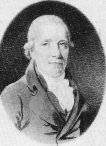
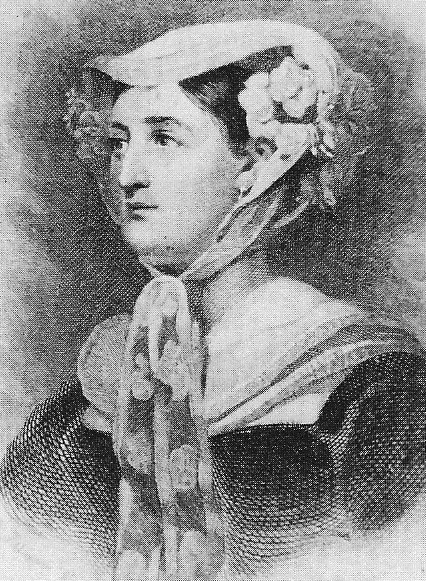
|
Sieur Joseph Serane and his first wife Henriette Bruce.
Images from MCR p.10.
|
Joseph Serane and Henriette
According to the family memories (MCR p.10-11),
Joseph had been admiral in the french royal fleet
but he fled the french revolution and stayed in the Caribbean.
He became auctioneer and solicitor in the aforesaid town of
Basseterre, Guadeloupe (marriage act of daughter Adelaide, 1815).
Children in Basseterre, Guadeloupe:
1798 Marie Francois Adelaide (different version of her name can
be found in the internet), and a boy (Joseph Henri?).
On rootschat.com, topic 5140660.0
one finds the image of a miniature of a boy in French attire,
that is surmised to show the son; no descendants known.
Josephs first wife Henriette died young.
Joseph remarried, but he died as well as his son.
The stepmother later sent her stepdaughter to a convent school.
According Dubois (2012,
p.340),
Serane had become sollicitor in Basse-Terre, Guadeloupe.
The documents of the office of Joseph Serane have been preserved
(Archives départementales de Gudeloupe [ADG], Notariat Serane).
From the references in the study by Dubois (2012) it follows that
Serane had his notariat from before 1794 until at least April 1803
(see Dubois, p.272).
For details see clippings.
He was active in 1793 in the
"Commission générale extraordinaire".
He was elector in the first elections after the french revolution on
Guadeloupe, in 1799, representing Basse-Terre.
In 1801 he registers protestations of several citizens
against the new (post-revolution) rules and regulations in Guadeloupe
(Régent, 2015).

|
His wife "Brousse" was a femme de coleur
(Dubois 2012,
p.340).
She must be the one: Henriette Bruce = Brousse!
Henriette may be the daughter of Charles Joseph de Brousse,
who had a navy duty in the Caribbean 1759-1785
(record from the archivesnationales.culture.gouv.fr)
and a mulâtresse.
John and Isabella
Following the family memories (MCR p8-9):
John joined the Gordon Highlanders,
a choice strongly disapproved by Johns father.
He married in 1804, as lieutenant John Cameron,
Isabella of Leanachan.
John was then stationed as soldier in various places,
among them Berbice in the Guianas.
John distinguished himself so brilliantly at the Battle of Waterloo (1815)
|
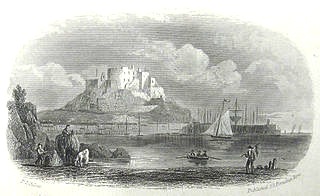
Castle Orgeuil, Jersey
|
that the Duke of Wellington personally commended him for courage.
Children: in Scotland 1806 Duncan(+),
in Berbice 1810 Ewen Philip, 1811 John;
then Castle Argeuil, Jersey, 1814 Donald Charles.
Then Lundavra, Inverness-shire:
1815 Allina(+), 1817 Allan (+1836),
1819 John Kennedy (+ Berbice), 1821 Angus Kennedy, 1822 Duncan(+),
1823 Alexander Gordon Matheson, 1826 Elizabeth Matheson.
Captain John Cameron later settled on his fathers leased farm at Kintail,
Ross-shire.
In 1835 he was listed, described as "John Cameron of Berbice",
as one of the five principal landowners in the parish of Kilmallie,
Inverness-shire.
He died in 1853.
MCR p.9: "The coffin was carried shoulder high across three counties,
so that he might be buried at the family burying place at Glen Nevis
[the valley just SW of Ben Nevis].
According to the custom amongst the Highland families in those days,
all the gentry of the county had sent their pipers who marched
with the procession."
Peter and Marie Francoise Adelaide Serane
Marie Francoise Adelaide was known as Adele.
At their marriage in 1815,
which was announced on St Martin (french part) and St Eustatius,
Peters parents lived on St Eustace,
Adeles parents had lived on Guadeloupe.
Following the memories of the family (MCR p.11),
Adele, as orphan,
was in a convent school when she decided to elope with Peter Moore,
the son of a Dutch-Irish family of merchants in Berbice.
"They were brought back and married.
Because of differences in religion and race,
there were three seperate wedding ceremonies.
The bride had a large dowry and a wedding contract was drawn up in
both French and English."
|

Adele Serane
(from MCR p.10)
|
Children: Harriet Adriana (1839 x Ewen Philip Cameron),
Eliza (1844 x Charles Sherlock), William Henry (unmarried),
1819 Margaret Anne (1844 x Donald Charles Cameron, brother of Ewen),
Jane(+), Maria Patricia (1846 x Robert Bridges),
Philip (died unmarried; he may have owned a plantation on
St. Eustatius, from which slaves escaped in ~1830; see Roitman 2016, p.391),
Seranette (x Adams), nn(+).
Peter is said to have gone through Adele's dowry,
using the money to further explore the jungle that he had developed.
But then Peter "disappeared" in the jungle.
Peter's bachelor brother William took care of the widow and children.
They now lived in Berbice, the former Dutch and since 1815 Britisch colony.
Later, in the late 1840s, Adele moved to England
and went to her daughter Eliza in Liverpool.
In the 1850 she is in London, with the children of her daughter and
with a cousin Adriana, daughter of Ann Patricia Moore, a sister of Peter.
The various relatives in the Guianas seem to have profided funds for all
these arrangements, Adeles household in London had servants.
In her old age she was cared for by her daughter Tishie (Patricia) and
husband Robert Bridges.
Robert died in London in a tragic train accident in the fog.
When Adele had died, Tishie moved to Australia to her sister Margaret
(MCR p.80).
Donald Cameron and Margaret Moore
For details see more.....
The Moore ancestry has been taken from
Sewell genealogy.
Data on Marie Francoise Adelaide Serane from
Cameron/Serane.
MCR: The stories were taken from
"A Strange Bird on the Lagoon" by Margaret Reeves
née Cameron
(1985, Boolarong Publications; ISBN 0908175 957).
Photos from MCR have been reproduced with permission
of the Cameron descendants.
Dubois, L., 2012. "A Colony of Citizens: Revolution and Slave Emancipation in the French Caribbean, 1787-1804"
Gilmore, R.G., 2016. In "African Re-Genesis";
Eds. J.B. Haviser, K.C. MacDonald; Routledge.
Régent, F., 2015. Préjugé de couleur, esclavage
et citoyennetés dans les colonies françaises (1789-1848);
in La Révolution Française, 2015/9.
Roitman, J.V., 2016. Land of hope and dreams: slavery and abolition in
the Dutch Leeward islands, 1825-1865, Slavery & Abolition, 37, 375-398.
# = "Legacies of British slave ownership"
(2017.04.19) original version 17 Feb. 2012.


